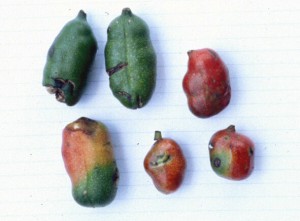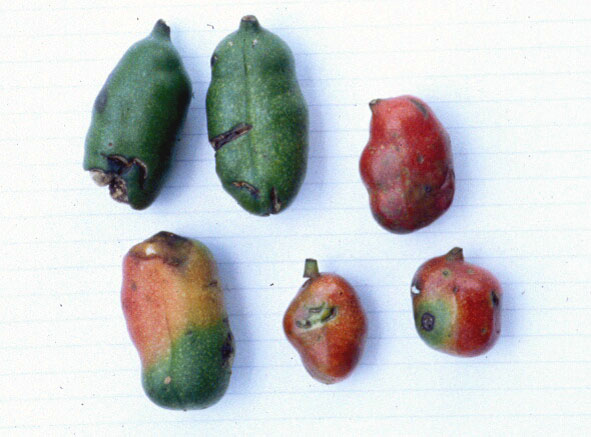Why do chimpanzees get into fights with their neighbors? As we report in this month’s Animal Behaviour, one of the major reasons seems to be food.
Since the 1970s, researchers have known that male chimpanzees defend group territories, and that fights between groups can be deadly. But what triggers these fights? Do chimpanzees go looking for trouble? Do they get into fights over mates? Or do they fight over some other resource, such as food? And when they do meet the neighbors, what determines whether they fight or flee? Are they more likely to respond aggressively if they are defending mates, or young infants, or food? Or does strength in numbers matter more? We sought to answer these questions, using 15 years of data on social behavior and ecology.
These data come from the Kanyawara community of chimpanzees in Kibale National Park, Uganda, where I did my PhD dissertation research as a student of Richard Wrangham and Marc Hauser. For the past decade, I’ve been doing fieldwork in Tanzania instead of Uganda, but I’ve continued to collaborate with Richard and his team. Such collaboration is made easier now that the long-term data have been entered into an Access database, and the original datasheets are all scanned, making it a simple matter to consult the original records from anywhere with good internet access.
Working with these data brought back many vivid memories, such as the day I first saw chimpanzees in the wild, back in June 1996. I had come to Kibale to spend a summer doing pilot research. We hiked for hours in the forest to find the chimpanzees, following narrow trails up and down steep hills, stepping carefully along narrow logs lain across boggy patches in the valley bottoms. Everything looked green and wet. Towering rainforest trees hung with vines. Dense stands of wild ginger and other leafy tropical plants crowded the understory.
 As we crept along a steep trail, an opening in the trees showed the misty green expanse of the valley below. At last, I caught my first fleeting glimpse of a chimpanzee – I think it was Stout, an adult male – as he crossed the trail. His long black hair glistened with rain as he knuckle-walked calmly but quickly through the forest, looking more like a gorilla than I had expected, having only seen chimpanzees in movies and zoos.
As we crept along a steep trail, an opening in the trees showed the misty green expanse of the valley below. At last, I caught my first fleeting glimpse of a chimpanzee – I think it was Stout, an adult male – as he crossed the trail. His long black hair glistened with rain as he knuckle-walked calmly but quickly through the forest, looking more like a gorilla than I had expected, having only seen chimpanzees in movies and zoos.
During my first weeks at Kanyawara, the chimps traveled in large parties with many males. I saw most members of the community, including old Lamy, with his crippled foot, new mothers Outamba and Tongo carrying their first infants, matriarch Lope and her family, including the gangly teenager Makoku and young Rosa, grey-bearded Stocky, tough young males Imoso and Johnny, and Big Brown, who was still the alpha male.
During my first few days in the field, the chimps hunted and killed a red colobus monkey, and had a brief, noisy, and (for me) completely confusing encounter with their neighbors, during which the stranger chimps came within sight of us, crashing through the underbrush, displaying at and running towards our chimps before running they turned and ran away. As it turns out, I had come just in time for the last weeks of Uvariopsis season.
Uvariopsis congensis is a small tree that grows in large groves in the understory of the forest. It tends to fruit synchronously, usually in May and June. The fruits are small and red, and look rather like fleshy red peanuts, with two or three seeds.
 At Kanyawara, the Uvariopsis groves occur mainly in the southeast of the range, along the border with another chimp community, which has not been habituated. And it turns out that that these Uvariopsis groves are a key focus of intergroup competition.
At Kanyawara, the Uvariopsis groves occur mainly in the southeast of the range, along the border with another chimp community, which has not been habituated. And it turns out that that these Uvariopsis groves are a key focus of intergroup competition.
Back when I was doing my dissertation work, the number of intergroup encounters that had been observed at Kanyawara was still too small for meaningful statistical analysis. But now, in the 15-year dataset, we have records of 120 intergroup encounters. As is typical for chimpanzees, most of these encounters were shouting matches rather than full-fledged fights – chimpanzees gave loud pant-hoots and waa-barks and other calls, challenging their neighbors, and then ran either towards or away from them. But when chimpanzees came close enough to see each other, they were always hostile. Two chimpanzees were killed, and several others badly injured. We found that these encounters happened mainly when chimpanzees visited border areas, especially the southern border.
So why did males visit border areas in the first place? To find mates, when few females in their own community were receptive? To find neighbors to attack, whenever they could gather in big enough parties to have a good chance of beating the neighbors? Or to look for food?
To answer these questions, we needed to use multivariate statistics to consider all these factors at once: mates, party composition, and food. We knew that male chimpanzees were highly motivated to search for mates, and we had previously found that parties that visited the range periphery had more males, presumably because that provided safety in numbers. But we also suspected that food would be an important part of the answer.
Chimpanzees spend most of their time searching for food, eating food, or digesting food. Though chimpanzees eat a variety of things, including monkeys, honey, ants, termites, leaves and stems, they spend most of their time eating ripe fruit from trees. In a tropical forest, the availability of tree fruits varies in a complex way over space and time. Some trees occur in groves in particular areas, whereas others are scattered about the forest. Some tree species, like figs, may produce food throughout the year, but other species fruit synchronously, with a big crop occurring every one or two years. To test how food influences chimpanzee movements, we needed data on both where and when key foods were located.
We had lots of data on feeding behavior. But it could be that chimpanzees travel to different parts of their range for social reasons (such as looking for mates or checking on the neighbors), and just happen to eat whatever they find along the way. So we needed to test whether the feeding data reflected where food was actually located. We therefore examined data from vegetation plots, and confirmed that both feeding data and vegetation plot data agreed that certain tree species were more common in the north, while others were more common in the south. For key species, we also found a good correlation between feeding behavior and independent measures of whether a sample of those trees had fruit in a given month. Additionally, the strong correlation between feeding records and counts of seeds from dung samples gave us confidence that our data on feeding behavior provided a good measure of what chimps were actually eating.
So what did we find?
Males tended to stay closer to the range center, and were less likely to travel to the south, when they were with more sexually receptive females. Party composition also mattered: as we had found previously, chimps were more likely to visit dangerous border areas when in parties with many males. And as we suspected, food had a big impact on chimpanzee movements. They visited the southern border mainly when southern fruits were in season. One species in particular had a strong effect on encounter rate: Uvariopsis. Most of the intergroup encounters took place in the southeast, in or near the Uvariopsis groves, and encounters were more likely to occur on days when chimps spent more time eating Uvariopsis.
So chimpanzees at Kanyawara visited borders for various reasons, but food seemed especially important. In particular, a good crop of Uvariopsis attracts chimps from both sides of the border, resulting in a spike in the rate of intergroup encounters during Uvariopsis season.
When encounters did occur, though, we found that the response depended mainly on the number of adult males that were present. Whether they were with mates, infants, or food didn’t matter as much as whether they had enough males to put up a good fight. These results were very much in line with what we had previously found with the playback experiments.
So is food generally the main driver of intergroup competition in chimpanzees? I’m currently working on data from Gombe to test whether similar factors apply there. It seems likely that in addition to food, the relative power of communities is a key factor. An interesting case in point is just 12 km from Kanyawara: the Ngogo community, studied by John Mitani and David Watts. This is the biggest chimpanzee community ever studied, with about 150 members. These chimps live in a range about the same size as Kanyawara’s, but in higher quality forest, with a lot more food, and three times the chimpanzees. And a lot more violence. The Ngogo chimps frequently patrol their boundaries, and in a ten-year period, Ngogo males killed 21 of their neighbors.
While the Ngogo chimps were killing their neighbors and expanding their range, the Kanyawara chimps were losing territory to their powerful southern neighbors (a group of unhabituated chimpanzees whose range appears to be sandwiched between Ngogo and Kanyawara). By 2006, the Kanyawara range was less than half as big as it had been in 1998, and the southern chimps had pushed the boundary a full kilometer north. It may be that chimps in a powerful community, like Ngogo, are more likely to go looking for trouble, whereas chimps in a weak community, like Kanyawara, visit dangerous border areas only when the abundance of food there makes the risk worthwhile.
